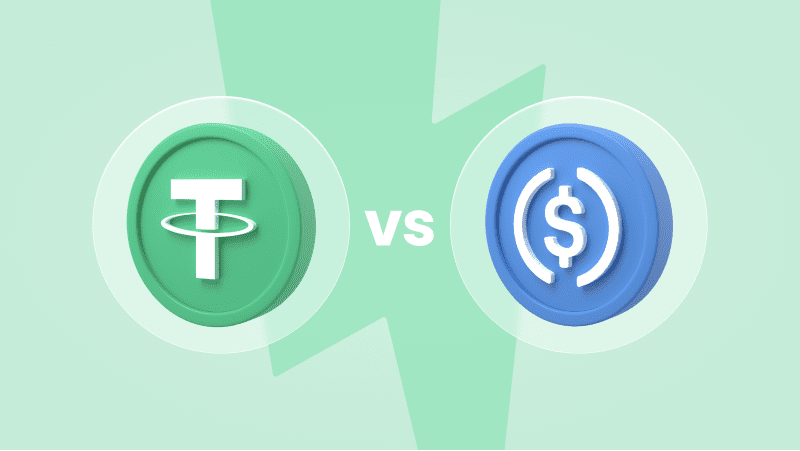Traders in the cryptocurrency space are well aware of the fast-paced market movements, which can experience significant price fluctuations in a matter of hours. Some traders consider this volatility as a feature, leveraging it to their advantage. However, this volatility complicates long-term investments in cryptocurrency and its use as an alternative store of value.
To address these challenges, stablecoins have risen to prominence. They serve various purposes, acting as a reliable medium of exchange. Additionally, they inherit several benefits associated with decentralized cryptocurrencies. Among stablecoins, USDC and USDT have gained significant popularity. But what sets them apart? Let’s explore the distinctions between these two stablecoins to help you decide which one suits your needs.
Understanding Stablecoins
Stablecoins represent a category of cryptocurrencies tethered, or “pegged,” to the value of another asset. The majority of stablecoins are pegged to fiat currencies, with both USDC and USDT being tied to the US dollar. Essentially, one unit of these stablecoins equates to approximately $1.00. As the name suggests, stablecoins offer a crucial stabilizing element within the inherently volatile cryptocurrency market.
Cryptocurrencies and the Challenge of Volatility
Cryptocurrencies like Bitcoin can experience price fluctuations of over 10% in just a few hours. This volatility complicates long-term investments in cryptocurrencies or their use as an alternative store of value. Imagine agreeing to sell an asset for one Bitcoin, only to see its value plummet by 5% immediately afterward. To address these concerns, traders often turn to stablecoins for everyday transactions due to their price stability. Stablecoins offer steady exchange rates and quick, secure transactions without intermediaries. They are stored in digital wallets and can be exchanged for various assets while preserving user privacy.
A Brief Historical Overview
In 2018, the USDC stablecoin was introduced by the Centre Consortium, a collaboration between cryptocurrency heavyweights Circle and Coinbase. Circle Internet Financial, a U.S.-based financial services firm, oversees the management of USDC. Importantly, the Centre Consortium functions as the official regulator for USDC, ensuring transparency for users.
USD Tether, or USDT, was introduced in late 2014 and operates on the OmniLayer, a platform built atop the Bitcoin blockchain. Originally named Realcoin, it later transitioned to USDT. It was a pioneering stablecoin, effectively pegging its value to the US dollar at a 1:1 ratio. Tether oversees the management of this stablecoin, including the minting of new USDT and its circulation.
Key Distinctions
Market Capitalization: The market cap of an asset represents the total market value, indicating the number of coins in circulation. It is influenced by supply and demand, serving as a significant indicator of an asset’s growth potential. As of the current moment, the market cap of USDC stands at $27 billion, while USDT’s market cap is $83.7 billion. The difference in market cap between the two has always been significant, with USDT having a much larger liquid trading volume available.
Backing: Both USDC and USDT are backed by various assets to maintain a consistent value. USDC is backed by cash and cash equivalents, providing the coin with stability. In contrast, USDT is backed by a mixture of cash, treasuries, and liquid debt, which diversifies its reserves.
Regulation: USDC is fully regulated and complies with U.S. regulations for anti-money laundering and know-your-customer purposes. It undergoes continuous scrutiny by U.S. regulators, ensuring its compliance. On the other hand, USDT’s compliance with regulations is less clear.
USDT Advantages
- Longevity: USDT has a longer history and wider circulation, making it more widely used.
- Trading Volume and Availability: USDT boasts a larger trading and liquidity volume and is traded on multiple blockchain platforms.
- Liquidity: USDT’s substantial market cap contributes to its higher liquidity, protecting traders from significant price swings.
- Market Sentiments: USDT is trusted within the cryptocurrency community, making it a preferred choice for many traders in exchange for other assets.
USDC Advantages
- Regulatory Compliance and Transparency: USDC is fully regulated and complies with U.S. regulations, providing a higher level of transparency and security.
- Simpler Reserves: USDC’s reserves consist solely of cash and cash equivalents, offering simplicity.
- Redemptions: USDC provides a simpler redemption process, enabling users to exchange their tokens through Circle via bank wires.
Making the Right Choice
The choice between USDC and USDT depends on your specific goals, location, and involvement in the cryptocurrency market. If you seek a widely-used stablecoin with a longer history, USDT may be the better choice. On the other hand, if you prioritize regulatory compliance, simplicity, and a secure redemption process, USDC by Circle Consortium is preferable.
In the unlikely event of a total collapse of the U.S. dollar, both stablecoins, pegged to USD, could see their values affected. However, such a scenario is highly unlikely. Alternatively, if cryptocurrencies were to surpass fiat currencies in the future, stablecoins could gain even more popularity while retaining their value.
In conclusion, both USDC and USDT have their advantages, and the choice between them ultimately depends on your preferences and needs. As with any cryptocurrency investment, conducting thorough research and staying updated on the latest developments is essential to make informed decisions.


